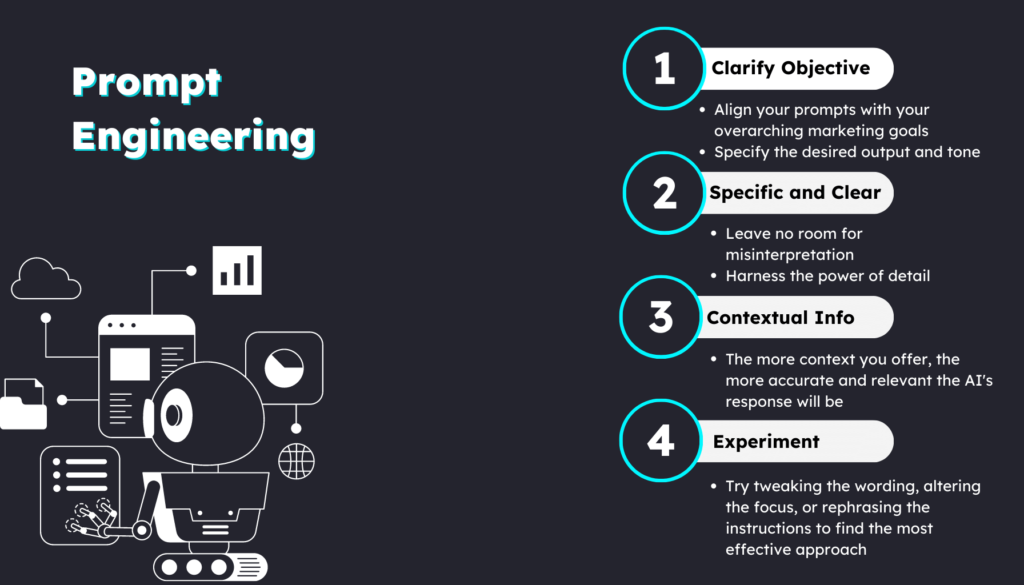
The intersection of AI and marketing has birthed novel possibilities, offering marketers an unprecedented toolkit to engage, persuade, and captivate audiences in ways previously deemed impossible. In a world where marketing and technology meet, a powerful tool has emerged; prompt engineering. This approach lets marketers use AI to create smart and creative campaigns.
This guide will explore prompt engineering, equipping you with the insights and strategies needed to master this relatively new practice. With the need for a bridge between human intent and machine-generated responses, prompts play a pivotal role in eliciting AI-powered creativity that resonates with audiences. Whether you’re embarking on your initial AI-powered marketing expedition or seeking to refine your existing approach, this guide is designed to illuminate the path to mastery in prompt engineering.
Understanding Prompts in AI-Powered Marketing
At the core of AI-powered marketing lies the concept of prompts; a bridge that connects the human marketer’s intent with the AI model’s potential. Think of prompts as instructions you give to the AI, guiding it to generate relevant and valuable content. It’s like laying out the foundation for a conversation with the AI, enabling it to respond in ways that align with your marketing objectives.
In the context of AI, prompts are structured inputs that trigger responses from AI models. These inputs can take various forms, such as questions, statements, or even incomplete sentences. The beauty of prompts is their adaptability; they allow you to shape the AI’s output according to your goals, whether it’s creating engaging ad copy, drafting social media posts, or extracting insights from data.
Consider a scenario where you want to streamline your social media content creation process using a SaaS platform. Your prompt could be as straightforward as, ‘Generate engaging social media posts for our upcoming product launch.’ Alternatively, for a market research task, your prompt might be, ‘Analyze social media trends and extract key insights about audience preferences and behaviors.’
Behind the Scenes: How Models Generate Responses
Picture prompt engineering as a collaborative dialogue between you and the AI model. You provide the initial input, the prompt, outlining your goal, and the AI responds with content that aligns with your intent. This interaction forms a creative partnership, where the AI’s computational abilities complement your marketing expertise.
Behind the seemingly magical generation of AI responses lies a process grounded in complex algorithms. When presented with a prompt, AI models internally analyze patterns from the vast data they’ve been trained on. This enables them to predict and produce text that logically follows the given input. The result is a crafted response that mirrors human language, yet is a product of computational understanding.
Understanding the dynamics of prompts is essential for harnessing the full potential of AI-powered marketing. With this foundation in place, we can explore the best practices that empower marketers to craft prompts that yield compelling and impactful AI-generated content.
Prompt Engineering Tips
1. Clarify Your Objective
When venturing into prompt engineering, the journey begins with a clear objective. Align your prompts with your overarching marketing goals to ensure the AI-generated content serves your purpose. For instance, if you’re aiming to promote a new fitness app, your prompt could be:
‘Create a persuasive tagline for our fitness app that highlights its unique features.’
To further enhance this alignment, specify the desired output and tone. If you’re targeting a youthful audience, your prompt could include instructions like
‘Generate an energetic and informal description of our new tech gadget.’
2. Be Specific and Clear
Ambiguity is the enemy of effective prompts. Craft your prompts to be specific and crystal clear, leaving no room for misinterpretation. Instead of vague instructions like ‘Write about healthy living,’ try
‘Compose a 200-word blog post about the benefits of including superfoods in your daily diet.’
Harness the power of detail to guide the AI’s creativity. For instance, if you’re developing a language translation software, your prompt might ask
‘Create a compelling tagline for our translation tool, underscoring its capacity to bridge language gaps and facilitate global communication.’
3. Provide Contextual Information
Context is the magic ingredient in prompt engineering. The more context you offer, the more accurate and relevant the AI’s response will be. If you’re seeking a product comparison blog post, provide data such as features, specifications, and customer reviews of the products in question. This enables the AI to create a comprehensive and informed piece.
For instance, if you’re tasking the AI to craft responses for a customer support chatbot, furnish the model with a background on common customer inquiries, so it can generate helpful and relevant answers.
4. Experiment with Different Approaches
Prompt engineering is an iterative process. Don’t hesitate to experiment with various prompt formulations to find the most effective approach. Try tweaking the wording, altering the focus, or rephrasing the instructions to see how the AI responds differently.
As you experiment, closely monitor the AI model’s performance. Adapt your strategies based on the quality of generated content. If your initial prompt for Instagram captions doesn’t yield the desired engagement, iterate with new angles, such as asking the AI to
‘Create Instagram captions with a touch of humor.’
By adhering to these best practices, you’ll be able to wield the art of prompt engineering with finesse, extracting the full potential of AI-driven creativity for your marketing endeavors.

Tailoring Prompts for Different Marketing Tasks
1. Content Generation
When it comes to content creation, prompt engineering becomes a versatile tool in a marketer’s arsenal. Craft prompts tailored to various content types, from engaging blog posts to persuasive ad copy and bite-sized social media content. For example, if you’re aiming to generate an engaging newsletter campaign for your SaaS analytics platform, your prompt could be
‘Compose an insightful and visually appealing newsletter highlighting the latest data trends and innovative techniques for leveraging analytics in SaaS development.’
Leverage AI to infuse creativity while maintaining your brand’s unique voice. If your brand persona is known for wit and humor, your prompt could be
‘Draft a humorous and quirky Instagram caption that complements the image of our latest product.’
2. Market Research and Insights
AI-powered queries are a game-changer in the realm of market research. Design prompts that instruct the AI to extract valuable insights from your data collection. For instance, if you have a database of customer feedback, your prompt could be
‘Analyze customer reviews and identify recurring pain points and positive experiences.’
When exploring consumer trends, your prompts can guide the AI to conduct trend analysis. For example
‘Track forum discussions across tech communities to uncover rising trends in cloud-based collaboration tools and remote work preferences.’
3. Email Marketing
Personalization is the golden rule of email marketing, and prompt engineering can elevate this practice. Craft prompts that guide AI to generate personalized email responses. For instance, a client asks about a feature’s integration. Your prompt could be
'Compose a helpful and clear response explaining how our SaaS solution seamlessly integrates with popular marketing tools, enhancing data flow and campaign management.'
By tailoring prompts to different marketing tasks, you enable AI to seamlessly integrate into various aspects of your strategy, from content generation and market research to personalized customer interactions. This adaptive approach harnesses the true potential of AI as a versatile ally in your marketing efforts.
Increase +180%
leads
demos
sales
bookings
from your website with AI
Get more conversions from your existing website traffic delivering personalized experiences.

Optimizing and Refining Prompt-Model Interaction
In prompt engineering, the journey doesn’t end with crafting a prompt; it’s the beginning of an iterative process. Gradual refinement is the key to unlocking the full potential of your prompts. Take a collaborative stance with the AI model’s responses – analyze them critically, identify areas of improvement, and evolve your prompts accordingly.
As you examine the AI-generated content, consider what worked well and what fell short. If you aimed for an engaging social media post but received lackluster results, refine your prompt gradually. For instance, if you were dissatisfied with an initial prompt like ‘Create a catchy Instagram caption,’ refine it to something more specific like
‘Compose a captivating Instagram caption that highlights the product's unique features.’
Effective prompt engineering thrives on collaboration between marketers and AI specialists. This dynamic partnership bridges the gap between human intuition and technological prowess. By working together, you can fine-tune prompts to yield remarkable results.
Foster a feedback loop where AI-generated responses are evaluated by both parties. AI specialists can provide insights into how the model interprets prompts and suggest adjustments to optimize outcomes. Marketers, on the other hand, can offer domain-specific expertise to refine prompts that align with marketing goals.
Gathering feedback and iterating prompts based on this collaboration is pivotal. Suppose your collaboration reveals that the AI struggles to capture the desired brand voice consistently. In that case, AI specialists could guide you in refining prompts that better guide the AI in emulating that voice.
This joint effort ensures that prompt engineering becomes an ever-improving process, where each iteration brings you closer to content that seamlessly marries your creative vision with AI-generated finesse.
Ethical Considerations in AI-Powered Marketing
1. Transparency and Honesty
As AI seamlessly integrates into marketing practices, transparency and honesty remain non-negotiable principles. Disclose the involvement of AI assistance to consumers whenever applicable. If a customer engages with a chatbot, for example, a simple note like ‘Chat handled with AI technology’ can enhance transparency and set clear expectations.
Whether it’s an automated email response, a social media post, or a recommendation on a website, ensure that consumers can readily discern AI’s involvement. Transparency fosters trust and prevents potential confusion or misinformation.
2. Bias Mitigation
AI, though transformative, isn’t immune to biases present in the data it learns from. As ethical marketers, it’s essential to review and mitigate biases in AI outputs. This involves examining AI-generated content to identify any unintended favoritism or exclusionary language.
Avoid the inadvertent reinforcement of harmful stereotypes. Craft prompts and refine AI models to be sensitive to cultural, gender, and social diversity.
Conclusion
Prompt engineering stands as a discipline that wields AI as a tool of innovation and amplifies the creative potential of marketers. This endeavor requires a steady hand, a discerning eye, and an unwavering commitment to ethical conduct.
As the journey of AI-powered marketing progresses, prompt engineering remains a guiding principle, ensuring that the fusion of human expertise and technological advancements continues to yield results of precision and impact.





